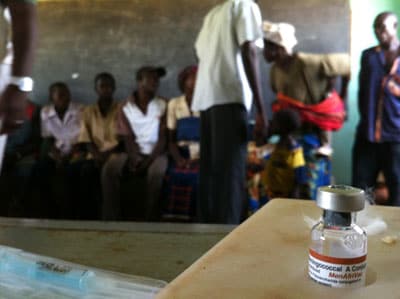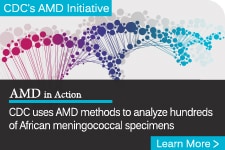Meningococcal Disease in Other Countries
Meningococcal disease occurs worldwide, with the highest incidence of disease found in the ‘meningitis belt’ of sub-Saharan Africa. In this region, major epidemics occur every 5 to 12 years with attack rates reaching 1,000 cases per 100,000 population. Other regions of the world experience lower overall rates of disease and occasional outbreaks. Annual attack rates in these regions averages around 0.3 to 3 per 100,000 population.

Photo of the MenAfriVac™ vaccine in Burkina Faso.
In the meningitis belt, serogroup A historically accounted for 9 in 10 meningococcal disease cases and the majority of large-scale epidemics. Starting in 2010, meningitis belt countries began implementing mass vaccination campaigns for a monovalent serogroup A meningococcal conjugate vaccine (MenAfriVac®). Held in 24 of the 26 target countries as of December 2021, these campaigns vaccinated 1 through 29 year olds. In addition, 12 countries introduced the vaccine into the routine childhood immunization program. Following vaccine introduction, epidemics due to serogroup A have been eliminated in vaccination areas. Recent epidemics have been primarily due to serogroups C and W. Serogroup X outbreaks have also been previously reported in this region.
Risk factors for meningococcal disease outbreaks in Africa are not fully understood. However, the following characteristics create favorable conditions for meningococcal disease epidemics:
- Dry and dusty conditions during the dry season between December to June
- Immunological susceptibility of the population
- Travel and large population displacements
- Crowded living conditions
In Europe, the Americas, and Australia, serogroups B, C, and Y together account for a large majority of cases. However, public health officials have observed increasing numbers of serogroup W in some areas. In temperate regions, the number of cases increases in winter and spring. The annual Hajj pilgrimage has also been associated with outbreaks of meningococcal disease due to serogroups A and W.
CDC response to meningococcal disease in Africa
CDC leads an international consortium called MenAfriNet in collaboration with
- World Health Organization
- African ministries of health
- Other partners
This consortium works to strengthen meningitis surveillance in sub-Saharan Africa. The primary goal is to evaluate the impact of MenAfriVac® on the incidence of meningococcal disease due to serogroup A. The consortium also monitors the emergence of disease and epidemics due to other serogroups. Learn more about MenAfriNet.
Read a blog about how labs play an integral role in defeating meningitis.
